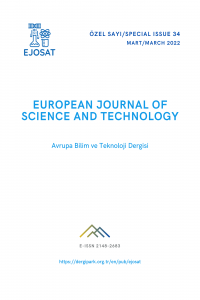Abstract
Sülfürün yüksek teorik kapasite, bulunabilirlik, düşük fiyat, doğa dostu özellikleri nedeniyle Lityum-sülfür bataryaları büyük ilgi çekmektedir. Ancak, düşük elektrokimyasal performans Li-sülfür bataryaların elektrokimyasal performansını kısıtlamaktadır. Ayırıcı ile katod arasına gözenekli elektriksel iletkenliği yüksek ara katman yerleştirilmesi aktif malzeme kullanımını arttırır ve polisülfid transferini kısıtlar böylece elektrokimasal özellikleri iyileştirir. SiO2 polar yapısı ve polisülfid ile güçlü elektrokimyasal etkileşimi ile elektrokimyasal performansı iyileştirir. SiO2 kaplı yüksek iletkenliğe sahip karbon nanolifler lityum sulfur bataryalarda arakatman olarak kullanıldı. Karbon nanolifler üzerindeki SiO2 kaplama SEM ve TEM ile görüntülendi. SiO2@CNF arakatmanlarla hazırlanan bataryalar yüksek spesifik kapasite gösterdi,1547 mAh/g, ve 200 deşarj-şarj sonunda 916 mAh/g kapasite elde edildi. Yüksek elektrokimyasal performans SiO2 nanoparçacıklarının yüksek yüzey alanı ve karbon nanoliflerin iletkenliği ie açıklanabilir.
References
- W. Kou, X. Li, Y. Liu, X. Zhang, S. Yang, X. Jiang, G. He, Y. Dai, W. Zheng, G. Yu, Triple-layered carbon-SiO2 composite membrane for high energy density and long cycling Li–S batteries, ACS nano 13(5) (2019) 5900-5909.
- C. Zhang, K. Li, J. Dai, X. Zhang, R. Li, J. Zou, High-performance lithium-sulfur batteries achieved by a multifunctional SiO2-nanotubes/carbon composite interlayer, Journal of Alloys and Compounds 895 (2022) 162580.
- J. Li, Y. Huang, S. Zhang, W. Jia, X. Wang, Y. Guo, D. Jia, L. Wang, Decoration of silica nanoparticles on polypropylene separator for lithium–sulfur batteries, ACS applied materials & interfaces 9(8) (2017) 7499-7504.
- J. Wang, Y. Yang, F. Kang, Porous carbon nanofiber paper as an effective interlayer for high-performance lithium-sulfur batteries, Electrochimica Acta 168 (2015) 271-276.
- A. Belgibayeva, I. Taniguchi, Insights into the improved electrochemical performance of lithium–sulfur battery with free-standing SiO2/C composite nanofiber mat interlayer, Journal of Power Sources 484 (2021) 229308.
- M. Liu, N. Deng, J. Ju, L. Fan, L. Wang, Z. Li, H. Zhao, G. Yang, W. Kang, J. Yan, A review: electrospun nanofiber materials for lithium‐sulfur batteries, Advanced Functional Materials 29(49) (2019) 1905467.
- T. Liu, X. Sun, S. Sun, Q. Niu, H. Liu, W. Song, F. Cao, X. Li, T. Ohsaka, J. Wu, A robust and low-cost biomass carbon fiber@ SiO2 interlayer for reliable lithium-sulfur batteries, Electrochimica Acta 295 (2019) 684-692.
- C. Zhang, K. Li, W. Luo, J. Dai, X. Zhang, R. Li, J. Zou, Z. Xu, SiO2 hollow nanotubes composite aramid fiber interlayer for absorbtion of polysulfides in highly stable lithium-sulfur batteries, Vacuum 195 (2022) 110684.
Abstract
Lithium-sulfur batteries have received great attention because of the high theoretical specific capacity, natural abundance, low cost, and environmental friendliness of sulfur. However, poor cycling and C-rate performance limit the application of Li-sulfur batteries. Placing porous and highly conductive interlayer between separators and sulfur cathodes is an efficient approach to improve active materials’ utilization and limit the polysulfide shuttle effect and thus enhance the electrochemical properties of Li-sulfur cells. Moreover, SiO2 could further improve electrochemical performance via capturing large amount of polysulfides owing to the polar structure and strong chemical interactions. SiO2 coated highly conductive carbon nanofibers were prepared and used as an interlayer in Li-sulfur batteries. The uniform coating of SiO2 nanoparticles on carbon nanofibers were observed from SEM and TEM images. The cells with SiO2 nanoparticles coated highly conductive carbon nanofiber (SiO2@CNF) interlayers delivered high first discharge capacity of 1547 mAh/g and retained the specific capacity of around 916 mAh/g in 200 cycles at 0.2C. The cells with SiO2@CNF interlayers also showed improved C-rate performance compared the cells without SiO2@CNF interlayers. The enhanced electrochemical performance resulted not only from high polysulfides capturing ability of SiO2 nanoparticles with high specific surface area but also highly conductive interconnected structure of carbon nanofibers. Highly porous structure of SiO2@CNF led to large amount of polysulfide adsorption and highly conductive structure resulted in reutilization of adsorbed polysulfides and thereby improved reversible specific capacities.
Keywords
References
- W. Kou, X. Li, Y. Liu, X. Zhang, S. Yang, X. Jiang, G. He, Y. Dai, W. Zheng, G. Yu, Triple-layered carbon-SiO2 composite membrane for high energy density and long cycling Li–S batteries, ACS nano 13(5) (2019) 5900-5909.
- C. Zhang, K. Li, J. Dai, X. Zhang, R. Li, J. Zou, High-performance lithium-sulfur batteries achieved by a multifunctional SiO2-nanotubes/carbon composite interlayer, Journal of Alloys and Compounds 895 (2022) 162580.
- J. Li, Y. Huang, S. Zhang, W. Jia, X. Wang, Y. Guo, D. Jia, L. Wang, Decoration of silica nanoparticles on polypropylene separator for lithium–sulfur batteries, ACS applied materials & interfaces 9(8) (2017) 7499-7504.
- J. Wang, Y. Yang, F. Kang, Porous carbon nanofiber paper as an effective interlayer for high-performance lithium-sulfur batteries, Electrochimica Acta 168 (2015) 271-276.
- A. Belgibayeva, I. Taniguchi, Insights into the improved electrochemical performance of lithium–sulfur battery with free-standing SiO2/C composite nanofiber mat interlayer, Journal of Power Sources 484 (2021) 229308.
- M. Liu, N. Deng, J. Ju, L. Fan, L. Wang, Z. Li, H. Zhao, G. Yang, W. Kang, J. Yan, A review: electrospun nanofiber materials for lithium‐sulfur batteries, Advanced Functional Materials 29(49) (2019) 1905467.
- T. Liu, X. Sun, S. Sun, Q. Niu, H. Liu, W. Song, F. Cao, X. Li, T. Ohsaka, J. Wu, A robust and low-cost biomass carbon fiber@ SiO2 interlayer for reliable lithium-sulfur batteries, Electrochimica Acta 295 (2019) 684-692.
- C. Zhang, K. Li, W. Luo, J. Dai, X. Zhang, R. Li, J. Zou, Z. Xu, SiO2 hollow nanotubes composite aramid fiber interlayer for absorbtion of polysulfides in highly stable lithium-sulfur batteries, Vacuum 195 (2022) 110684.
Details
| Primary Language | English |
|---|---|
| Subjects | Engineering |
| Journal Section | Articles |
| Authors | |
| Early Pub Date | January 30, 2022 |
| Publication Date | March 31, 2022 |
| Published in Issue | Year 2022 Issue: 34 |

